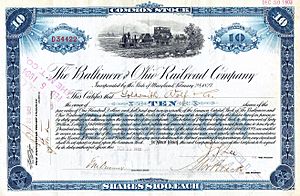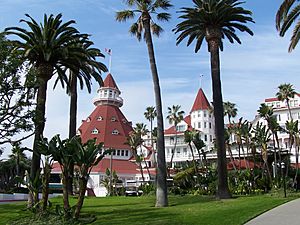Charles T. Hinde facts for kids
Quick facts for kids
Charles T. Hinde
|
|
|---|---|
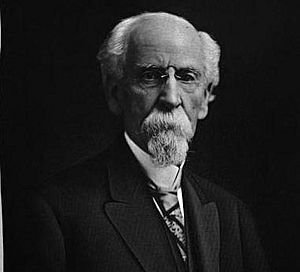 |
|
| Born | July 12, 1832 |
| Died | March 10, 1915 (aged 82) |
| Resting place | Mount Hope Cemetery, San Diego, California |
| Alma mater | Indiana Asbury University (renamed Depauw University in 1884) (dropped out) |
| Occupation | Business magnate, philanthropist |
| Known for | Co-founding the Hotel del Coronado |
| Board member of | Coronado Beach Company Spreckels Bros. Commercial Co. Halliday Brothers Galena, Dubuque and St. Paul Packet Co. St. Louis & Memphis Packet Co. Baltimore and Ohio Railroad Chesapeake and Ohio Railroad Global Grain & Milling Co. San Diego Electric Railway Co. Hinde, Verhoeff, & Co. Chas. T. Hinde & Co |
| Spouse(s) | Eliza Halliday |
| Children | Camilla Hinde |
| Parent(s) | Thomas S. Hinde and Sara Cavileer Hinde |
| Relatives | Dr. Thomas Hinde (grandfather) Edmund C. Hinde (brother) Frederick Hinde Zimmerman (nephew) Harry Hinde (nephew) William P. Halliday (brother-in-law) Charles H. Constable (uncle) |
| Signature | |
Charles T. Hinde (born July 12, 1832 – died March 10, 1915) was an important American businessman and leader. He was known for managing many companies and investing in different projects throughout his life. Hinde held top positions in river shipping, railroad companies, and the hotel business. By his late 40s, he had already become very wealthy from his work in steamboats and railroads.
In the late 1880s, Hinde moved to San Diego. His good friend E. S. Babcock invited him to invest in and help run several businesses. These included the famous Hotel del Coronado and the Spreckels Brothers Commercial Company, which he worked on with John D. Spreckels. Hinde became even richer during his time in southern California. He also helped the local economy grow a lot. Later in his life, he gave away much of his money to support projects in Coronado and nearby areas. Some of these donations were made in memory of his daughter, Camilla, who passed away at age 13.
Contents
Early Life and Family History
Charles T. Hinde was born in Urbana, Ohio, on July 12, 1832. He was one of six children. His parents were Thomas S. Hinde and Sara Cavileer Hinde. Charles's grandfather, Dr. Thomas Hinde, was a hero during the American Revolutionary War.
When Charles was young, his family moved around a lot. This was because his father was a traveling preacher for the Methodist church. His father also bought and sold land in new territories. Eventually, Hinde's father bought a large piece of land in southern Illinois. There, he started a town and settled down with his family.
Education and First Jobs
Hinde went to elementary and middle school in Mount Carmel, Illinois. This town was founded by his father in 1815. The Hinde family owned a lot of land in Mount Carmel and Wabash County, Illinois. Some of their land was along the Wabash River.
Hinde attended Indiana Asbury University (now DePauw University) for about a year and a half. He had to leave college after both his father and mother died. Charles, his brother Edmund C. Hinde, and his sister Belinda had to live with relatives or find ways to support themselves. For a short time, Charles and Belinda lived with their older sister, Martha, and her husband.
After leaving college, Hinde first worked as a grocery clerk in Vincennes. Later, he worked as a clerk in Mount Carmel. Even though these jobs didn't pay much, he could support himself. This was because he had inherited a lot of land from his father.
Working on Riverboats
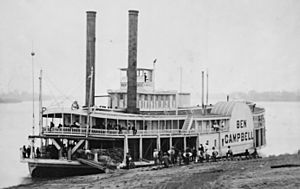
Charles Hinde's first job in river transportation was as a clerk on a boat. This boat traveled between St. Louis, Missouri, and St. Paul, Minnesota. After about a year, he joined the Galena, Dubuque and St. Paul Packet Company. This company grew to be one of the biggest transportation companies in the region.
During his time there, Hinde got very sick with cholera and almost died. But he recovered and quickly moved up in the company. In his mid-twenties, he was promoted to captain, which was very young for such a position. In 1862, he went to Louisville, Kentucky. There, he took command of a steamboat that traveled from Louisville to Memphis, Tennessee.
Hinde returned to St. Louis in 1864. He became captain of the steamboat Davenport, which ran from St. Louis to St. Paul. He later left that job to start a branch of the Halliday Brothers Corporation in Cairo, Illinois. This company was involved in river transportation and shipping. Hinde then started his own business. He became the shipping agent at the Cairo wharf for all steamboat lines on the Ohio River and Mississippi River. Soon after, he sold his share in the business. He moved his family to Evansville, Indiana, where he met E. S. Babcock and the Reid Brothers.
Moving into Railroads
After the Civil War, railroads became very strong competitors to steamboats. In 1870, after a short period of poor health, Hinde sold his river shipping businesses. He then focused on railroads. He went to Louisville, Kentucky, to rest. By chance, he became a shipping agent for the Baltimore and Ohio Railroad Company. He had good connections with some of the company's leaders.
Hinde got contracts to transport grain. He might have learned about the grain business from his brother, Edmund C. Hinde, who was active in it. However, this railroad venture didn't go well, and the Baltimore and Ohio Railroad faced financial trouble. Hinde then moved all his shipments to the Chesapeake and Ohio Railroad Company.
Just before he was invited to move to Coronado, California, Hinde's only child, Camilla, died in Evansville at age 13. His friend E. S. Babcock, who had founded the Hotel del Coronado, invited Hinde to invest and help manage his businesses. Hinde had been in the railroad business for less than ten years when he left for southern California. There, he invested with John D. Spreckels and E. S. Babcock in real estate and hotels. In the years that followed, Hinde and Spreckels started many successful businesses together and became close friends.
Life in Southern California
In Evansville, Hinde had met the Reid Brothers, who designed many famous buildings. When Hinde and Babcock moved to Coronado, they brought the Reid Brothers with them. They hired the brothers to design many buildings, including the Hotel del Coronado. Hinde also hired the Reid Brothers for his own projects. These included his home in Coronado and a church and rectory he built in the town. All three of these buildings are still standing today.
In California, Hinde became involved in many different businesses and investments. First, he was a commercial agent and manager for the Santa Fe Wharf, working with Spreckels and Babcock. Later, he helped start the Spreckels Brothers Commercial Company, owning one-third of it. This company imported coal, cement, and other goods.
Hinde's most important and lasting investment was the Hotel del Coronado. This hotel was owned by the Coronado Beach Company. The company was started with $3 million. The directors of the company were Babcock, Spreckels, Hinde, H.W. Mallett, and Giles Kellogg. They formed the company on April 7, 1886, and began building the hotel.
The company also made many other investments in the Coronado area. However, their plans were interrupted by the Panic of 1893. This was a serious economic downturn caused by problems in the railroad business. The economy did not start to get better until 1897. After a few slow years, the property market in southern California began to recover. Just like his move from riverboats to railroads, Hinde's switch from railroads to hotels greatly increased his wealth. From the company's start until his death in 1915, Hinde remained the vice president and treasurer of both the Coronado Beach Company and the Spreckels Brothers Commercial Company.
Later Life and Giving Back
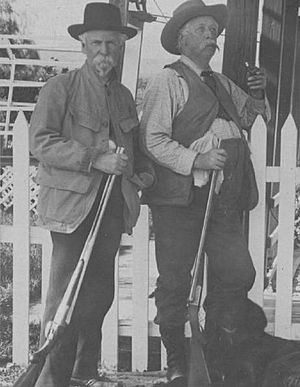
At age 72, Hinde started investing in property and mines in New Mexico as a hobby. He mostly used his nephews, Harry Hinde and Frederick Hinde Zimmerman, to find new business opportunities. Local newspapers reported on his investments, but he only made small profits from them.
In 1910, Hinde bought the most expensive car at the California Auto Show. It was a huge 72-horsepower Thomas Flyer car. He paid $6,200 for it and drove it back to his home in San Diego, California.
Hinde knew many important businessmen and politicians of his time because of his many business interests. One of his closest friends was James J. Hill of the Pacific Railroad. Hinde met him while working in the railroad business. Hinde usually stayed out of politics. However, later in his life, he started to support Republican politicians. His nephew, Harry Hinde, who was a Republican politician, encouraged him.
During the 1912 United States presidential election, Hinde hosted President William Howard Taft at his home in Coronado. Taft, a Republican, was campaigning for re-election against Theodore Roosevelt and Woodrow Wilson. Hinde and Taft went hunting and horse riding. Hinde also introduced Taft to many of his friends and business contacts. President Taft lost the election that year.
Towards the end of his life, Hinde gave money to many charities in southern California. He was especially generous to Coronado and San Diego. He paid for the building of Christ Episcopal Church in Coronado, along with its parish center and rectory. All these buildings were dedicated to his daughter, Camilla, who had passed away.
Even though Hinde gave a lot, he remained humble and quiet throughout his life. He did not like to receive credit for his giving. This might be why his contributions were not well-known after his death. Hinde left a large part of his money to his sister Belinda's son, Frederick Hinde Zimmerman. Frederick used the money to build the Grand Rapids Hotel on the Hinde family farm in Mount Carmel. Hinde left an even larger part of his money and his house in Coronado to his nephew, Harry Hinde.
Charles T. Hinde passed away in Coronado on March 10, 1915, at the age of 82. As he wished, his funeral service was simple. It was held in the Episcopal Church he built for the people of Coronado. Hinde is buried in Mount Hope Cemetery, San Diego, California. His estate papers showed that he was also a part-owner of the Global Grain & Milling Company, based in Los Angeles.
Images for kids
See also
 In Spanish: Charles T. Hinde para niños
In Spanish: Charles T. Hinde para niños


